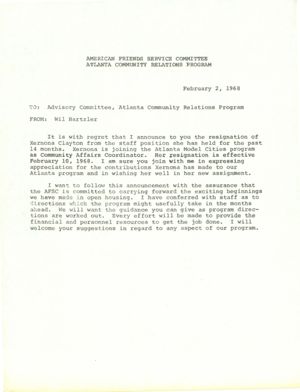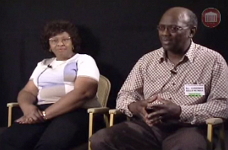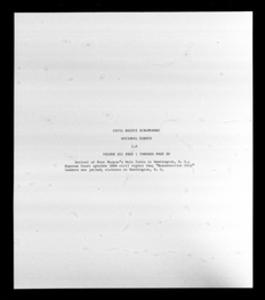Poor People's Campaign
- Title:
- Poor People's Campaign
- Years:
- 1968
- Description:
- In the wake of Martin Luther King Jr.'s death, the fate of his final cause, the Poor People's Campaign, faced an uncertain future. As chairman of the Southern Christian Leadership Conference (SCLC), King committed the organization's resources to the Poor People's Campaign in 1967, in response to the string of urban riots that had recently occurred in New York, New Jersey, Chicago and Los Angeles. The goal of the campaign was to emphasize the plight of the poor and to push the country's lawmakers to pass federal legislation to improve the economic and social conditions of the impoverished. At the time of King's death, members of the SCLC were in the midst of planning a massive demonstration of the nation's poor in Washington, D.C. Following King's assassination, Ralph Abernathy took over leadership of the SCLC and vowed to continue work on the Poor People's Campaign in memory of his fallen colleague. In May of 1968, demonstrators descended on the nation's capitol, arriving by foot, car, bus, horse-drawn carriage, and mule train. While in Washington, the protestors lived in Resurrection City, an encampment set up on the National Mall, which maintained dining and daycare facilities, a dispensary, and its own City Hall. For the next six weeks, thousands of participants poured into Resurrection City and staged daily demonstrations at the offices of government officials and their agencies. Despite the efforts of the organizers and participants, the Poor People's Campaign and their march on Washington failed to garner the intended response from the country's legislators. On June 19, 1968, following a demonstration at Lincoln Memorial, Resurrection City closed and the Poor People's Campaign reached an uneventful end.
- Archival Collections And Reference Resources:
-
180 items in 20 collections (expand all)
American Friends Service Committee, printed materials, 1968-1969
- Creator:
- AFL-CIO. Civil Rights Department
American Friends Service Committee
American Friends Service Committee. Atlanta Community Relations Program - Date of Original:
- 1968
1969 - Collection:
- AFL-CIO Southeast Division Civil Rights Department Records
- Contributing Institution:
- Georgia State University. Special Collections
Assorted organizations, reports and bulletins, 1964-1971
- Creator:
- AFL-CIO. Civil Rights Department
Delta Ministry of Mississippi
Episcopal Society for Cultural and Racial Unity
Mississippi Council on Human Relations
Virginia Council on Human Relations
Southern Regional Council
Penn Community Services - Date of Original:
- 1964
1965
1966
1967
1968
1969
1970
1971
1972 - Collection:
- AFL-CIO Southeast Division Civil Rights Department Records
- Contributing Institution:
- Georgia State University. Special Collections
Poor People's Campaign mule train in Bessemer, Alabama, traveling from Marks, Mississippi, to Washington D.C.
- Creator:
- Ayres, Jerry
- Date of Original:
- 1968-06-05
- Collection:
- Alabama Media Group Collection
- Contributing Institution:
- Alabama. Department of Archives and History
Poor People's Campaign mule train in Bessemer, Alabama, traveling from Marks, Mississippi, to Washington D.C.
- Creator:
- Ayres, Jerry
- Date of Original:
- 1968-06-05
- Collection:
- Alabama Media Group Collection
- Contributing Institution:
- Alabama. Department of Archives and History
Poor People's Campaign mule train in Bessemer, Alabama, traveling from Marks, Mississippi, to Washington D.C.
- Creator:
- Ayres, Jerry
- Date of Original:
- 1968-06-05
- Collection:
- Alabama Media Group Collection
- Contributing Institution:
- Alabama. Department of Archives and History
Poor People's Campaign mule train in Bessemer, Alabama, traveling from Marks, Mississippi, to Washington D.C.
- Creator:
- Ayres, Jerry
- Date of Original:
- 1968-06-05
- Collection:
- Alabama Media Group Collection
- Contributing Institution:
- Alabama. Department of Archives and History
Poor People's Campaign mule train in Bessemer, Alabama, traveling from Marks, Mississippi, to Washington D.C.
- Creator:
- Ayres, Jerry
- Date of Original:
- 1968-06-05
- Collection:
- Alabama Media Group Collection
- Contributing Institution:
- Alabama. Department of Archives and History
Letter on Law and Order, 1
- Creator:
- Gore, Albert, 1907-1998
- Date of Original:
- 1968-06-21
- Collection:
- Albert Gore Sr. Senate Collection
- Contributing Institution:
- Albert Gore Research Center (Murfreesboro, Tenn.)
Audio Recording of Interview on the Poor People's Campaign with Ralph David Abernathy, undated
- Date of Original:
- 1932/2025
- Collection:
- Andrew J. Young Oral Histories
- Contributing Institution:
- Auburn Avenue Research Library on African-American Culture and History
--Even worst, suppose this ? was on the ballot box in your district?-- / Baldy, [1968 May 13].
- Creator:
- Baldowski, Clifford H., 1917-1999
- Date of Original:
- 1968-05-13
- Collection:
- Baldy Editorial Cartoons, 1946-1982, 1997: Clifford H. Baldowski Editorial Cartoons at the Richard B. Russell Library.
- Contributing Institution:
- Richard B. Russell Library for Political Research and Studies
Hot pursuit / Baldy, [1968 June 18]
- Creator:
- Baldowski, Clifford H., 1917-1999
- Date of Original:
- 1968-06-18
- Collection:
- Baldy Editorial Cartoons, 1946-1982, 1997: Clifford H. Baldowski Editorial Cartoons at the Richard B. Russell Library.
- Contributing Institution:
- Richard B. Russell Library for Political Research and Studies
Carlos Montes oral history interview conducted by David P. Cline in Alhambra, California, 2016 June 27
- Date of Original:
- 2016
- Collection:
- Civil Rights History Project
- Contributing Institution:
- American Folklife Center
Gloria Arellanes oral history interview conducted by David P. Cline in El Monte, California, 2016 June 26
- Date of Original:
- 2016
- Collection:
- Civil Rights History Project
- Contributing Institution:
- American Folklife Center
Juadine Henderson oral history interview conducted by Emilye Crosby in Washington, DC, District of Columbia, 2015 December 03
- Date of Original:
- 2015
- Collection:
- Civil Rights History Project
- Contributing Institution:
- American Folklife Center
Maria Varela oral history interview conducted by David P. Cline in Pasadena, California, 2016 June 29
- Date of Original:
- 2016
- Collection:
- Civil Rights History Project
- Contributing Institution:
- American Folklife Center
Coretta Scott King
- Creator:
- Uffelman, Minoa D.
- Date of Original:
- 2008-03-12
- Collection:
- Encyclopedia of Alabama
- Contributing Institution:
- Encyclopedia of Alabama (Project)
Oral history interview with Krendell Petway Dendy and Reverend Alfonso K. Petway, 2001
- Creator:
- Petway, Kredelle, 1941-
- Date of Original:
- 2001
- Collection:
- Freedom Riders' 40th Anniversary Oral History Project, 2001
- Contributing Institution:
- John Davis Williams Library. Department of Archives and Special Collections
Speech, January 15, 1981, Birthday Celebration, Dr. Martin Luther King, Jr., Wofford College
- Creator:
- Newman, I. DeQuincey (Isaiah DeQuincey), 1911-1985
- Date of Original:
- 1981-01-15
- Collection:
- Isaiah DeQuincey Newman, (1911-1985), Papers, 1929-2003
- Contributing Institution:
- University of South Carolina. South Carolina Political Collections
Albert Turner speaking to a crowd at Maggie Street Baptist Church in Montgomery, Alabama.
- Creator:
- Peppler, Jim
- Date of Original:
- 1968-02
- Collection:
- Jim Peppler Southern Courier Photograph Collection
- Contributing Institution:
- Alabama. Department of Archives and History
Audience at Maggie Street Baptist Church in Montgomery, Alabama, probably listening to Hosea Williams speak.
- Creator:
- Peppler, Jim
- Date of Original:
- 1968-02
- Collection:
- Jim Peppler Southern Courier Photograph Collection
- Contributing Institution:
- Alabama. Department of Archives and History
Audience at Maggie Street Baptist Church in Montgomery, Alabama, probably listening to Hosea Williams speak.
- Creator:
- Peppler, Jim
- Date of Original:
- 1968-02
- Collection:
- Jim Peppler Southern Courier Photograph Collection
- Contributing Institution:
- Alabama. Department of Archives and History
Audience at Maggie Street Baptist Church in Montgomery, Alabama, probably listening to Martin Luther King, Jr., speak.
- Creator:
- Peppler, Jim
- Date of Original:
- 1968-02
- Collection:
- Jim Peppler Southern Courier Photograph Collection
- Contributing Institution:
- Alabama. Department of Archives and History
Audience at Maggie Street Baptist Church in Montgomery, Alabama, probably listening to Martin Luther King, Jr., speak.
- Creator:
- Peppler, Jim
- Date of Original:
- 1968-02
- Collection:
- Jim Peppler Southern Courier Photograph Collection
- Contributing Institution:
- Alabama. Department of Archives and History
Audience at Maggie Street Baptist Church in Montgomery, Alabama, probably listening to Martin Luther King, Jr., speak.
- Creator:
- Peppler, Jim
- Date of Original:
- 1968-02
- Collection:
- Jim Peppler Southern Courier Photograph Collection
- Contributing Institution:
- Alabama. Department of Archives and History
King's Last March
- Creator:
- Smith, Stephen
- Date of Original:
- 2008
- Collection:
- King's Last March
- Contributing Institution:
- American Public Media
Oral History Interview with Adolph Arms, August 17, 2007, part I
- Creator:
- Arms, Adolph Thomas
- Date of Original:
- 2007-08-17
- Collection:
- March on Milwaukee: Civil Rights History Project
- Contributing Institution:
- Golda Meir Library. Special Collections
Oral History Interview with Margaret (Peggy) Rozga, August 19, 2008, part II
- Creator:
- Rozga, Margaret
- Date of Original:
- 2008-08-19
- Collection:
- March on Milwaukee: Civil Rights History Project
- Contributing Institution:
- Golda Meir Library. Special Collections
Oral History Interview with Mary Arms, July 29, 2007, part I
- Creator:
- NAACP Youth Council Commandos
- Date of Original:
- 2007-07-29
- Collection:
- March on Milwaukee: Civil Rights History Project
- Contributing Institution:
- Golda Meir Library. Special Collections
Oral History Interview with Mary Arms, July 29, 2007, part II
- Creator:
- National Association for the Advancement of Colored People
Winn, Amanda - Date of Original:
- 2007-07-29
- Collection:
- March on Milwaukee: Civil Rights History Project
- Contributing Institution:
- Golda Meir Library. Special Collections
Photograph of participants in the Poor People's March, Nashville, Tennessee, 1968 May 08
- Creator:
- Gunter, Jack
- Date of Original:
- 1968-05-08
- Collection:
- Nashville Public Library Digital Collections Portal: Civil Rights
- Contributing Institution:
- Nashville Public Library (Tenn.). Special Collections Division
Coretta Scott King (1927-2006)
- Creator:
- McCarty, Laura
- Date of Original:
- 2006-11-03
- Collection:
- New Georgia Encyclopedia
- Contributing Institution:
- New Georgia Encyclopedia (Project)
Poor People's Campaign March
- Creator:
- Warren K. Leffler
- Date of Original:
- 1968-06-18
- Collection:
- New Georgia Encyclopedia
- Contributing Institution:
- New Georgia Encyclopedia (Project)
Poor People's Campaign 1968
- Creator:
- Southern Christian Leadership Conference
- Date of Original:
- 1968
- Collection:
- Print Culture of the Civil Rights Movement, 1950-1980
- Contributing Institution:
- Amistad Research Center
Poor People's Campaign flyer
- Creator:
- Southern Christian Leadership Conference
- Date of Original:
- 1968
- Collection:
- Print Culture of the Civil Rights Movement, 1950-1980
- Contributing Institution:
- Amistad Research Center
The Poor People's Campaign
- Creator:
- Southern Christian Leadership Conference
- Date of Original:
- 1968
- Collection:
- Print Culture of the Civil Rights Movement, 1950-1980
- Contributing Institution:
- Amistad Research Center
Tyrone Brooks, 02 September 2009.
- Creator:
- Brooks, Tyrone, 1945
Short, Bob, 1932 - Date of Original:
- 2009-09-02
- Collection:
- Reflections on Georgia Politics oral history collection, 2006-2010
- Contributing Institution:
- Richard B. Russell Library for Political Research and Studies
Wilie Bolden, 07 October 2009.
- Creator:
- Short, Bob, 1932
Bolden, Willie, 1938 - Date of Original:
- 2009-10-07
- Collection:
- Reflections on Georgia Politics oral history collection, 2006-2010
- Contributing Institution:
- Richard B. Russell Library for Political Research and Studies
Civil Rights Movement scrapbooks. National events volume 12
- Date of Original:
- 1968/1969
- Collection:
- The Scrapbooks
- Contributing Institution:
- Birmingham Public Library (Ala.)
Poor People's March at Lafayette Park and on Connecticut Avenue
- Creator:
- Leffler, Warren K.
- Date of Original:
- 1968-06-18
- Collection:
- Voices of Civil Rights
- Contributing Institution:
- Library of Congress
Letter on Law and Order, 1
- Date of Original:
- 1968/2023
- Collection:
- Volunteer Voices
- Contributing Institution:
- University of Tennessee, Knoxville. Special Collections
Abernathy says the march to Washington will be re-routed through Memphis.
- Creator:
- WSB-TV (Television station : Atlanta, Ga.)
- Date of Original:
- 1968-04-06
- Collection:
- WSB-TV Newsfilm Collection
- Contributing Institution:
- Walter J. Brown Media Archives and Peabody Awards Collection
Abernathy talks about poor people's march to Washington.
- Creator:
- WSB-TV (Television station : Atlanta, Ga.)
- Date of Original:
- 1968-04-18
- Collection:
- WSB-TV Newsfilm Collection
- Contributing Institution:
- Walter J. Brown Media Archives and Peabody Awards Collection
Coretta King on the Poor People's Campaign in D.C. Joe Boone leading service before buses leave for D.C. (1968).
- Creator:
- WSB-TV (Television station : Atlanta, Ga.)
- Date of Original:
- 1968
- Collection:
- WSB-TV Newsfilm Collection
- Contributing Institution:
- Walter J. Brown Media Archives and Peabody Awards Collection









![--Even worst, suppose this ? was on the ballot box in your district?-- / Baldy, [1968 May 13].](https://crdl.usg.edu/thumbnails/dlg/bald/dlg_bald_ph-383.jpg)
![Hot pursuit / Baldy, [1968 June 18]](https://crdl.usg.edu/thumbnails/dlg/bald/dlg_bald_am-1157.jpg)



























